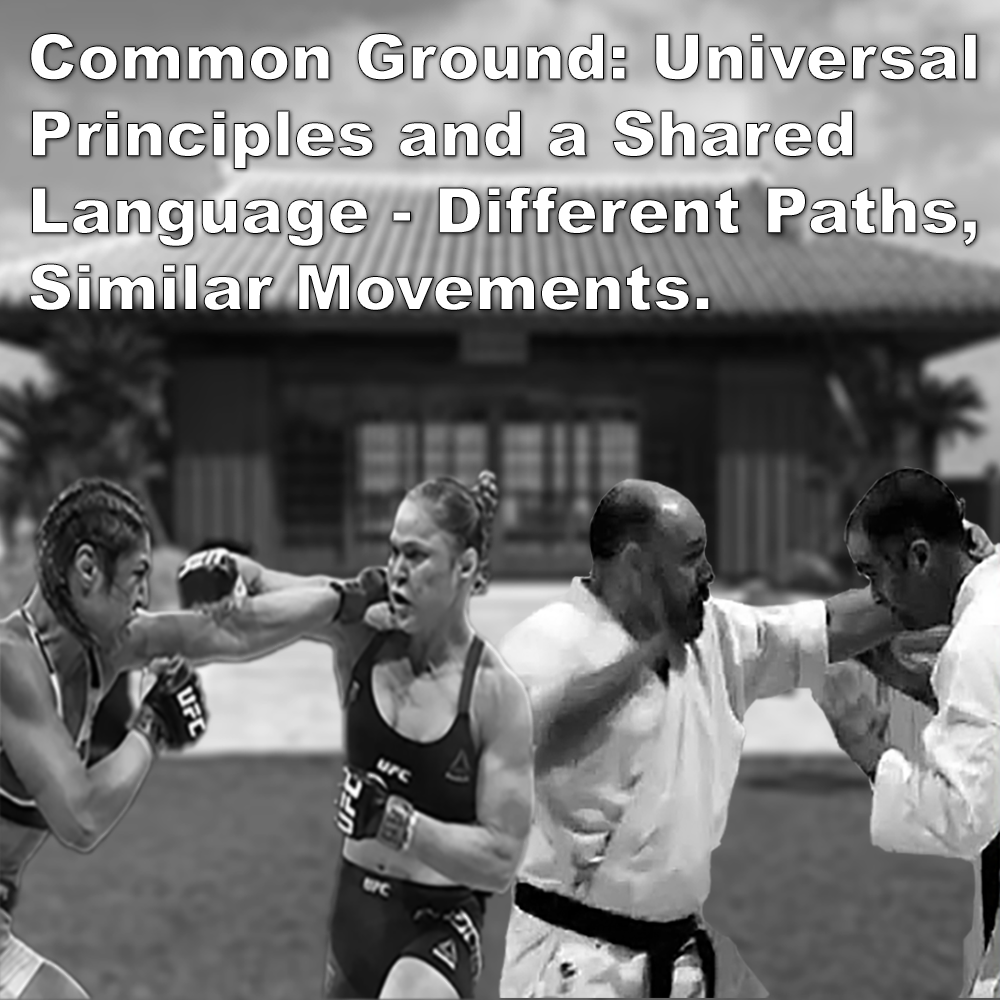
Common Ground: Universal Principles and a Shared Language – Different Paths, Similar Movements.
Posted by ADAM CARTER on NOV 06, 2024

Common Ground: Universal Principles and a Shared Language – Different Paths, Similar Movements.
(Approx 2 minute 45 second read)
The comments on my articles are inspiring, often funny, and sometimes, just uninformed.
To all the armchair enthusiasts, keyboard warriors, and practitioners from other methods who think kata is useless – let’s get this out of the way: You do not fight with kata.
The kata were created as a mnemonic. What’s a mnemonic? A memory aid or technique that helps you remember information more easily. At the time of their creation, kata were essentially the “styles” of their day – a teacher’s complete system of fighting. Just like many martial artists today have their own styles and methods, kata embodied the teacher’s approach to combat.
Back then, there were no books, no photography, no videos, and no other practical method to record or remember these movements. Kata were designed for students to remember the two-person drills they’d practiced so they could train alone. They were never meant to be a standalone performance or demonstration, nor a method to pass a test.
Here’s a recent comment: “When I watch demonstrations, I see people performing the kata fighting different opponents, which doesn’t look real.”
Unfortunately, this is where things went astray. With the modernization of karate in the early 20th century, karate shifted from being a method of self-protection to a practice aimed at building healthy bodies, fostering competition, and cultivating character and personal development.
Many of us today are working to revive our karate’s earlier roots, making it practical and pragmatic. We focus on self-protection through the principles and techniques found within kata.
Another comment I often hear is, “Why not remove kata altogether and just focus on sparring?” We could – but sparring isn’t the whole answer either. When kata is understood correctly, its is a powerful toolkit of movements and principles that distinguish karate from other methods.
What most critics fail to understand when they say, “Good luck fighting with your kata” – and I’ll repeat myself from above – is that; ‘You do not fight with kata’.
So let’s clarify.
Take away the solo template for a moment. For pragmatic application purposes, you don’t need to perform kata strictly from start to finish. Each movement can be extracted and used as needed, in any order. Notice I said movement not technique. Sometimes, only one movement is required, or perhaps several, depending on the situation – just as with any other method.
Kata is not a strict series of techniques but rather a collection of adaptable movements. Each of these movements has multiple applications. Take, for example, a movement that looks like a stepping punch. At first glance, it might look like a single technique, but that movement could also be a grab, a pull, a push, or even a wedge. It’s the movement that is important from beginning to end, not a strict labelled technique. Just because the hand is closed, doesn’t mean it’s a punch.
The value of kata lies in this flexibility. It’s not about memorizing a series of fixed moves; it’s about internalizing principles that can be adapted and applied based on the situation at hand.
People have asked what I think about “practical karate” practitioners trying to match MMA techniques to kata. The answer is simple: the human body can only move in so many ways. Many movements in kata are indeed similar to techniques used in MMA, or other martial arts. Experienced practitioners know these techniques aren’t unique to any one method.
So let me reiterate: Kata, in its pragmatic form, is not a fight sequence, a performance or rigid routine. It’s a way of teaching principles and movements, a way to internalize adaptable movements you can apply as needed.
Kata isn’t useless or outdated. It’s a part of karate’s depth and is what makes karate different in today’s world. Kata takes us back to the teachers of long ago who used their “styles” to protect themselves and others.
That’s worth keeping, isn’t it?
Written by Adam Carter – Shuri Dojo.
